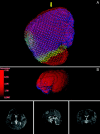A sparse intraoperative data-driven biomechanical model to compensate for brain shift during neuronavigation
- PMID: 21087939
- PMCID: PMC7965704
- DOI: 10.3174/ajnr.A2288
A sparse intraoperative data-driven biomechanical model to compensate for brain shift during neuronavigation
Abstract
Background and purpose: Intraoperative brain deformation is an important factor compromising the accuracy of image-guided neurosurgery. The purpose of this study was to elucidate the role of a model-updated image in the compensation of intraoperative brain shift.
Materials and methods: An FE linear elastic model was built and evaluated in 11 patients with craniotomies. To build this model, we provided a novel model-guided segmentation algorithm. After craniotomy, the sparse intraoperative data (the deformed cortical surface) were tracked by a 3D LRS. The surface deformation, calculated by an extended RPM algorithm, was applied on the FE model as a boundary condition to estimate the entire brain shift. The compensation accuracy of this model was validated by the real-time image data of brain deformation acquired by intraoperative MR imaging.
Results: The prediction error of this model ranged from 1.29 to 1.91 mm (mean, 1.62 ± 0.22 mm), and the compensation accuracy ranged from 62.8% to 81.4% (mean, 69.2 ± 5.3%). The compensation accuracy on the displacement of subcortical structures was higher than that of deep structures (71.3 ± 6.1%:66.8 ± 5.0%, P < .01). In addition, the compensation accuracy in the group with a horizontal bone window was higher than that in the group with a nonhorizontal bone window (72.0 ± 5.3%:65.7 ± 2.9%, P < .05).
Conclusions: Combined with our novel model-guided segmentation and extended RPM algorithms, this sparse data-driven biomechanical model is expected to be a reliable, efficient, and convenient approach for compensation of intraoperative brain shift in image-guided surgery.
Figures



Similar articles
-
Estimation of intraoperative brain shift by combination of stereovision and doppler ultrasound: phantom and animal model study.Int J Comput Assist Radiol Surg. 2015 Nov;10(11):1753-64. doi: 10.1007/s11548-015-1216-z. Epub 2015 May 10. Int J Comput Assist Radiol Surg. 2015. PMID: 25958061
-
A comparison of thin-plate spline deformation and finite element modeling to compensate for brain shift during tumor resection.Int J Comput Assist Radiol Surg. 2020 Jan;15(1):75-85. doi: 10.1007/s11548-019-02057-2. Epub 2019 Aug 23. Int J Comput Assist Radiol Surg. 2020. PMID: 31444624 Free PMC article.
-
Quantification of, visualization of, and compensation for brain shift using intraoperative magnetic resonance imaging.Neurosurgery. 2000 Nov;47(5):1070-9; discussion 1079-80. doi: 10.1097/00006123-200011000-00008. Neurosurgery. 2000. PMID: 11063099
-
Brain shift in neuronavigation of brain tumors: A review.Med Image Anal. 2017 Jan;35:403-420. doi: 10.1016/j.media.2016.08.007. Epub 2016 Aug 24. Med Image Anal. 2017. PMID: 27585837 Review.
-
[Image-guided neurosurgery using intraoperative MRI].Brain Nerve. 2009 Jul;61(7):823-34. Brain Nerve. 2009. PMID: 19618860 Review. Japanese.
Cited by
-
Clinical evaluation of a model-updated image-guidance approach to brain shift compensation: experience in 16 cases.Int J Comput Assist Radiol Surg. 2016 Aug;11(8):1467-74. doi: 10.1007/s11548-015-1295-x. Epub 2015 Oct 17. Int J Comput Assist Radiol Surg. 2016. PMID: 26476637 Free PMC article.
-
A nonrigid registration method for correcting brain deformation induced by tumor resection.Med Phys. 2014 Oct;41(10):101710. doi: 10.1118/1.4893754. Med Phys. 2014. PMID: 25281949 Free PMC article.
-
Intraoperative image updating for brain shift following dural opening.J Neurosurg. 2017 Jun;126(6):1924-1933. doi: 10.3171/2016.6.JNS152953. Epub 2016 Sep 9. J Neurosurg. 2017. PMID: 27611206 Free PMC article.
-
Intraoperative Imaging Modalities and Compensation for Brain Shift in Tumor Resection Surgery.Int J Biomed Imaging. 2017;2017:6028645. doi: 10.1155/2017/6028645. Epub 2017 Jun 5. Int J Biomed Imaging. 2017. PMID: 28676821 Free PMC article. Review.
-
Near Real-Time Computer Assisted Surgery for Brain Shift Correction Using Biomechanical Models.IEEE J Transl Eng Health Med. 2014 Apr 30;2:2500113. doi: 10.1109/JTEHM.2014.2327628. IEEE J Transl Eng Health Med. 2014. PMID: 25914864 Free PMC article.
References
-
- Roberts DW, Hartov A, Kennedy FE, et al. . Intraoperative brain shift and deformation: a quantitative analysis of cortical displacement in 28 cases. Neurosurgery 1998;43:749–60 - PubMed
-
- Hill DL, Maurer CR, Jr, Maciunas RJ, et al. . Measurement of intraoperative brain surface deformation under a craniotomy. Neurosurgery 1998;43:514–28 - PubMed
-
- Dorward NL, Alberti O, Velani B, et al. . Postimaging brain distortion: magnitude, correlates, and impact on neuronavigation. J Neurosurg 1998;88:656–62 - PubMed
-
- Du GH, Zhou LF, Mao Y, et al. . Intraoperative brain shift in neuronavigator-guided surgery. Chin J Minim Invasive Neurosurg 2002;7:3–6
-
- Gumprecht H, Lumenta CB. Intraoperative imaging using a mobile computed tomography scanner. Minim Invasive Neurosurg 2003;46:317–22 - PubMed
Publication types
MeSH terms
LinkOut - more resources
Full Text Sources
